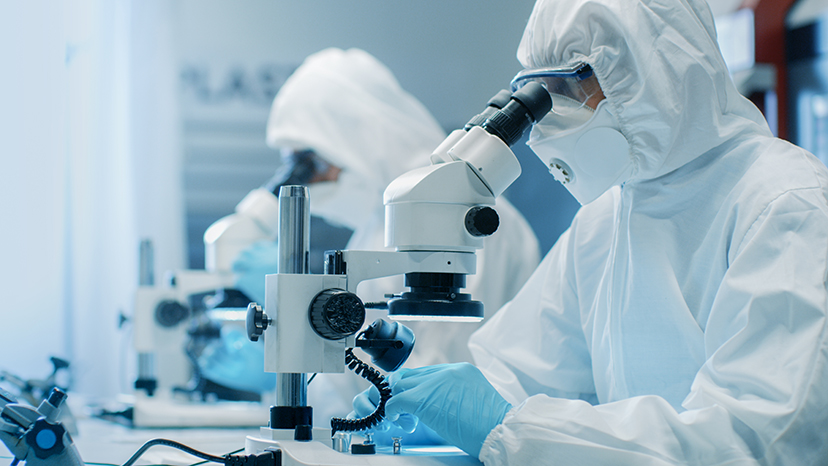Cleanroom standards are some of the most stringent to adhere to. A cleanroom must be meticulously cleaned and disinfected depending on the type of research, development or assembly taking place within it. For instance, a clean room used for developing or assembling pharmaceuticals has a wide range of factors that will contribute to its classification, depending on how clean the room needs to be in order for untainted assembly and production to take place.
For any R&D facility or controlled environment where sensitive components or products are assembled, a cleanroom cleaning company has to be well-versed on a number of different factors that contribute to their sanitation tactics when tackling the proper disinfection.
One of the main factors that influence cleanroom cleaning companies when considering what products and procedures to use is the cleanroom’s classification. Learn what the classifications mean and about the cleaning procedures that should ensue for each.
What Is a Cleanroom Classification?
Cleanrooms are classified from a rating of ISO 1 to ISO 9 depending on their use and function within a facility. Cleanrooms can also be classified by the discontinued US FED STD 209E classification system, but for the sake of this article, we’ll be using the widely implemented ISO 14664-1 Standards. Note that there are separate EU systems as well.
The varying numbers in the ISO 1 to ISO 9 classification rating system relate to the concentration of particles in the cleanroom or clean area’s air. Ratings can also correspond to pressure, humidity, climate and other environmental factors that must be controlled for successful production1.
For instance, an ISO 3 cleanroom can have 35 Maximum Particles/ft3, per 0.1 micrometer. Juxtaposed to an ISO 8 cleanroom which allows 1.0 x 108 Maximum Particles/ft3, per 0.1 micrometer. In layman’s terms, the classification of a cleanroom sets a guideline for the amount of particulate matter allowed in a concentrated space of air. The higher the number, the less the concentration, while lower numbers correspond to higher particle concentrations in the air. ISO 9 cleanrooms are classified as “room air” meaning the same particulate concentration is allowed as a non-clean environment.
Each cleanroom classification requires different equipment and conditions to preserve the integrity of the environment, which require different cleaning techniques and tactics in order to correctly and effectively disinfect the space.
Cleanroom Cleaning Procedure
It’s of the utmost importance that cleaning staff members are suited up properly to enter the cleanroom. Before cleaning staff enter the room, make sure that they properly disinfect and dress by:
- Wiping shoes on sticky pads and cleaning with a shoe brush cleaner before covering footwear in protective plastic shoe cover booties
- Washing hands thoroughly with soap and water (or waterless alcohol for USP 797 cleanrooms) before putting on glove liners
- Applying alcohol solution to glove liners and putting on cleanroom gloves as well as applying additional layer of alcohol to cleanroom gloves
- Wearing cleanroom bouffant caps and beard covers for cleaning staff with facial hair
- Applying a fresh cleanroom hood and facemask
- Putting on coveralls and tucking hoods into coveralls
- Applying coverall gloves and booties that overlap the outside of the coveralls
Once a cleanroom cleaning staff has sufficiently suited up and spot checked with provided mirrors and other members of the team, they can safely enter the cleanroom and begin the cleaning process.
Cleaning staff should be using preapproved disinfectants and cleaning products in the controlled environment to guarantee the validity of the cleanroom for its intended purpose. Deionized water should be used to scrub every applicable surface, including floors, walls and benches. Use an autoclave ready multi-bucket mopping system with designated clean and dirty water control to prevent the reuse of previously used water. Floors should be mopped and vacuumed dry daily, and mopped and disinfected with a cleanroom detergent and vacuumed weekly.
Cleanroom walls should be vacuumed daily and scrubbed with deionized water using a cleanroom sponge as well as vacuumed weekly. Windows and pass-throughs should be wiped and washed with cleanroom approved lint-free wipes. Cleanroom ceilings should be vacuumed daily and washed with deionized water and a cleanroom approved sponge weekly. Any cleanrooms that are used in production that could result in deposits forming on the ceiling should use deionized water and a cleanroom detergent weekly to remove them. Overhead light lenses should be washed with deionized water and a cleanroom-approved detergent on a weekly basis as well.
After cleaning, cleanroom staff must exit the cleanroom and de-gown in a given staging area, taking care to dispose of used gowns in the proper receptacle, and to dispose of refuse from vacuums and mop buckets in the proper receptacles. Cleanroom staff must also take time to disinfect equipment as necessary.
It’s also viable to use electrostatic disinfection to clean cleanrooms, as the sterile mixture doesn’t affect the integrity of the controlled environment. A cleaning crew would simply spray the entirety of the cleanroom (removing sensitive equipment or products beforehand) and vacuum the spray off the surfaces of the cleanroom.
Need a consultation for your cleanroom cleaning procedure? Contact the cleanroom cleaning professionals to schedule a walk-through today.

